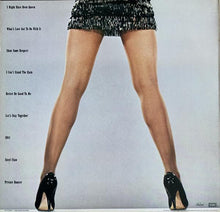Sonic Grade
Side One: 
Side Two: 
Vinyl Grade
Side One: Mint Minus to Mint Minus Minus
Side Two: Mint Minus to Mint Minus Minus
- You'll find very good Hot Stamper sound throughout this vintage Capitol pressing - exceptionally quiet vinyl too
- It's richer, fuller and with more presence than the average copy, and that's especially true for whatever godawful Heavy Vinyl pressing is currently being foisted on an unsuspecting record buying public
- 4 1/2 stars: "In 1984, a 45-year-old Tina Turner made one of the most amazing comebacks in the history of American popular music... Without question, this was Turner's finest hour as a solo artist."

100% Money Back Guarantee on all Hot Stampers
FREE Domestic Shipping on all LP orders over $150
Vintage covers for this album are hard to find in exceptionally clean shape. Most of the will have at least some amount of ringwear, seam wear and edge wear. We guarantee that the cover we supply with this Hot Stamper is at least VG.
This vintage Capitol pressing has the kind of Tubey Magical Midrange that modern records can barely BEGIN to reproduce. Folks, that sound is gone and it sure isn't showing signs of coming back. If you love hearing INTO a recording, actually being able to "see" the performers, and feeling as if you are sitting in the studio with the band, this is the record for you. It's what vintage all analog recordings are known for -- this sound.
If you exclusively play modern repressings of vintage recordings, I can say without fear of contradiction that you have never heard this kind of sound on vinyl. Old records have it -- not often, and certainly not always -- but maybe one out of a hundred new records do, and those are some pretty long odds.
What The Best Sides Of Private Dancer Have To Offer Is Not Hard To Hear
- The biggest, most immediate staging in the largest acoustic space
- The most Tubey Magic, without which you have almost nothing. CDs give you clean and clear. Only the best vintage vinyl pressings offer the kind of Tubey Magic that was on the tapes even as late as 1984
- Tight, note-like, rich, full-bodied bass, with the correct amount of weight down low
- Natural tonality in the midrange -- with all the instruments having the correct timbre
- Transparency and resolution, critical to hearing into the three-dimensional studio space
No doubt there's more but we hope that should do for now. Playing the record is the only way to hear all of the qualities we discuss above, and playing the best pressings against a pile of other copies under rigorously controlled conditions is the only way to find a pressing that sounds as good as this one does.
Standard Operating Procedures
What are sonic qualities by which a record -- any record -- should be judged? Pretty much the ones we discuss in most of our Hot Stamper listings: energy, vocal presence, frequency extension (on both ends), transparency, spaciousness, harmonic textures (freedom from smear is key), rhythmic drive, tonal correctness, fullness, richness, three-dimensionality, and on and on down the list.
When we can get a number of these qualities to come together on the side we’re playing, we provisionally give it a ballpark Hot Stamper grade, a grade that is often revised during the shootout as we hear what the other copies are doing, both good and bad.
Once we’ve been through all the side ones, we play the best of the best against each other and arrive at a winner for that side. Other copies from earlier in the shootout will frequently have their grades raised or lowered based on how they sounded compared to the eventual shootout winner. If we’re not sure about any pressing, perhaps because we played it early on in the shootout before we had learned what to listen for, we take the time to play it again.
Repeat the process for side two and the shootout is officially over. All that’s left is to see how the sides of each pressing match up.
It may not be rocket science, but it’s a science of a kind, one with strict protocols that we’ve developed over the course of many years to insure that the results we arrive at are as accurate as we can make them.
The result of all our work speaks for itself, on this very record in fact. We guarantee you have never heard this music sound better than it does on our Hot Stamper pressing -- or your money back.
What We're Listening For On Private Dancer
- Energy for starters. What could be more important than the life of the music?
- Then: presence and immediacy. The vocals aren't "back there" somewhere, lost in the mix. They're front and center where any recording engineer worth his salt would put them.
- The Big Sound comes next -- wall to wall, lots of depth, huge space, three-dimensionality, all that sort of thing.
- Then transient information -- fast, clear, sharp attacks, not the smear and thickness so common to these LPs.
- Tight punchy bass -- which ties in with good transient information, also the issue of frequency extension further down.
- Next: transparency -- the quality that allows you to hear deep into the soundfield, showing you the space and air around all the instruments.
- Extend the top and bottom and voila, you have The Real Thing -- an honest to goodness Hot Stamper.
Vinyl Condition
Mint Minus Minus and maybe a bit better is about as quiet as any vintage pressing will play, and since only the right vintage pressings have any hope of sounding good on this album, that will most often be the playing condition of the copies we sell. (The copies that are even a bit noisier get listed on the site are seriously reduced prices or traded back in to the local record stores we shop at.)
Those of you looking for quiet vinyl will have to settle for the sound of other pressings and Heavy Vinyl reissues, purchased elsewhere of course as we have no interest in selling records that don't have the vintage analog magic of these wonderful recordings.
If you want to make the trade-off between bad sound and quiet surfaces with whatever Heavy Vinyl pressing might be available, well, that's certainly your prerogative, but we can't imagine losing what's good about this music -- the size, the energy, the presence, the clarity, the weight -- just to hear it with less background noise.
Tina's Best Record
We consider this Tina Turner release from 1984 her Masterpiece. Others that belong in that category can be found here.
Side One
- I Might Have Been Queen
- What's Love Got To Do With It
- Show Some Respect
- I Can't Stand The Rain
- Better Be Good To Me
Side Two
- Let's Stay Together
- 1984
- Steel Claw
- Private Dancer
AMG 4 1/2 Star Review
In 1984, a 45-year-old Tina Turner made one of the most amazing comebacks in the history of American popular music. A few years earlier, it was hard to imagine the veteran soul/rock belter reinventing herself and returning to the top of the pop charts, but she did exactly that with the outstanding Private Dancer. And Turner did so without sacrificing her musical integrity.
To be sure, this pop/rock/R&B pearl is decidedly slicker than such raw, earthy, hard-edged Ike & Tina classics as "Proud Mary," "Sexy Ida," and "I Wanna Take You Higher." But she still has a tough, throaty, passionate delivery that serves her beautifully on everything from the melancholy, reggae-influenced "What's Love Got to Do With It" to the gutsy "Better Be Good to Me" to heartfelt remakes of the Beatles' "Help," Al Green's "Let's Stay Together," and David Bowie's "1984." A reflection on the emptiness of a stripper's life, the dusky title song is as poignant as it is depressing. Without question, this was Turner's finest hour as a solo artist.






